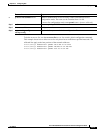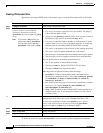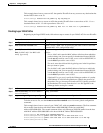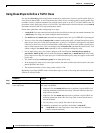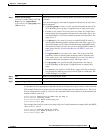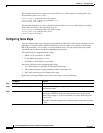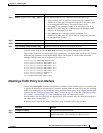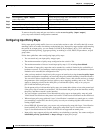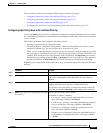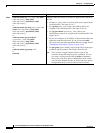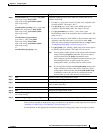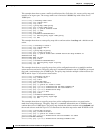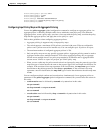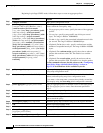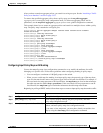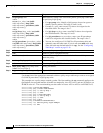
33-39
Cisco ME 3400 Ethernet Access Switch Software Configuration Guide
OL-9639-06
Chapter 33 Configuring QoS
Configuring QoS
These sections describe how to configure different types of input policy maps:
• Configuring Input Policy Maps with Individual Policing, page 33-39
• Configuring Input Policy Maps with Aggregate Policing, page 33-43
• Configuring Input Policy Maps with Marking, page 33-45
• Configuring Per-Port Per-VLAN QoS with Hierarchical Input Policy Maps, page 33-47
Configuring Input Policy Maps with Individual Policing
You use the police policy-map class configuration command to configure individual policers to define
the committed rate limitations, committed burst size limitations of the traffic, and the action to take for
a class of traffic.
Follow these guidelines when configuring individual policers:
• Policing is supported only on input policy maps.
• The switch supports a maximum of 229 policers. (228 user-configurable policers and 1 policer
reserved for internal use). You can configure up to 45 policers on a port.
• When you use a table map for police exceed-action in an input policy map, the protocol type of the
map from type of action must be the same as the protocol type of the associated classification. For
example, if the associated class map represents an IP classification, the map from type of action
that references the table map must be dscp or precedence. If the associated class map represents a
non-IP classification, the map from type of action that references the table map must be cos.
Beginning in privileged EXEC mode, follow these steps to create an input policy map with individual
policing:
Command Purpose
Step 1
configure terminal Enter global configuration mode.
Step 2
policy-map policy-map-name Create a policy map by entering the policy map name, and enter
policy-map configuration mode. By default, no class maps are
defined.
Step 3
class {class-map-name | class-default} Enter a class-map name or class-default to match all unclassified
packets, and enter policy-map class configuration mode.
If you enter a class-map name, you must have already created the
class map by using the class-map global configuration command.
Step 4
police {rate-bps | cir cir-bps} [burst-bytes | bc
burst-bytes]
Define a policer for the class of traffic.
By default, no policer is defined.
• For rate-bps, specify average traffic rate in bits per second
(bps). The range is 8000 to 1000000000.
• For cir cir-bps, specify a committed information rate (CIR) in
bits per second (bps). The range is 8000 to 1000000000.
• For burst-bytes (optional), specify the normal burst size in
bytes. The range is 8000 to 1000000.
• For bc burst-bytes (optional), specify the conformed burst (bc)
or the number of acceptable burst bytes. The range is 8000 to
1000000.



